Russian River Cruise: Arriving in St Petersburg
Read Part I of My Very Russian River Cruise from Moscow to St. Petersburg here.
The Zosima Shashkov slipped into her berth at St. Petersburg, the northern Russian capital, during the night. The St Petersburg cruise port lies a few miles outside the city center but on the River Neva that winds through the city, so I awoke early to see the view. I was disappointed to only see docks, but still excited to be in the city I had yearned to visit for decades. I dressed in layers — it was cold (56F) with a strong wind, but lots of blue sky — and my rain jacket. I wasn’t to need it. St. Petersburg weather is challenging for visitors as it averages only thirty days a year of sunshine — I was to enjoy three of them back to back.
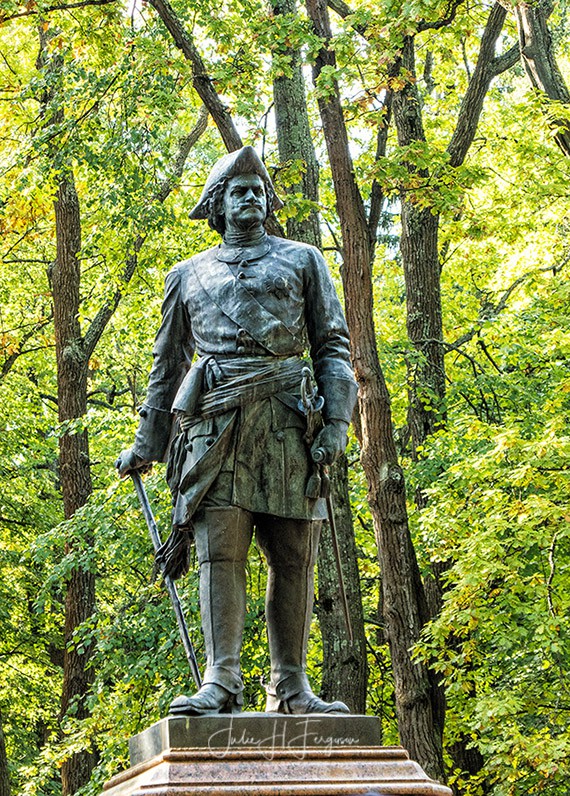
Highlights of St. Petersburg Russia
Day one in Peter the Great’s city began with a coach tour whipping us around the highlights too fast. St. Petersburg lies on the Gulf of Finland, which gave the tsar’s 17th-century navy access to the Baltic Sea and Scandinavia. The Neva’s delta was a challenging choice for building because it was marshy land threaded with rivers and dotted with islands. Despite this, Peter set out to create a sophisticated western city in 1703 reminiscent of Paris to replace Moscow as the capital of Russia and to elevate his own standing in the west. Yes, St. P. is in stark contrast to Moscow — more elegant, better planned, and crisscrossed with canals.
I found a knowledge of Russian history made the St. Petersburg’s tours come alive.
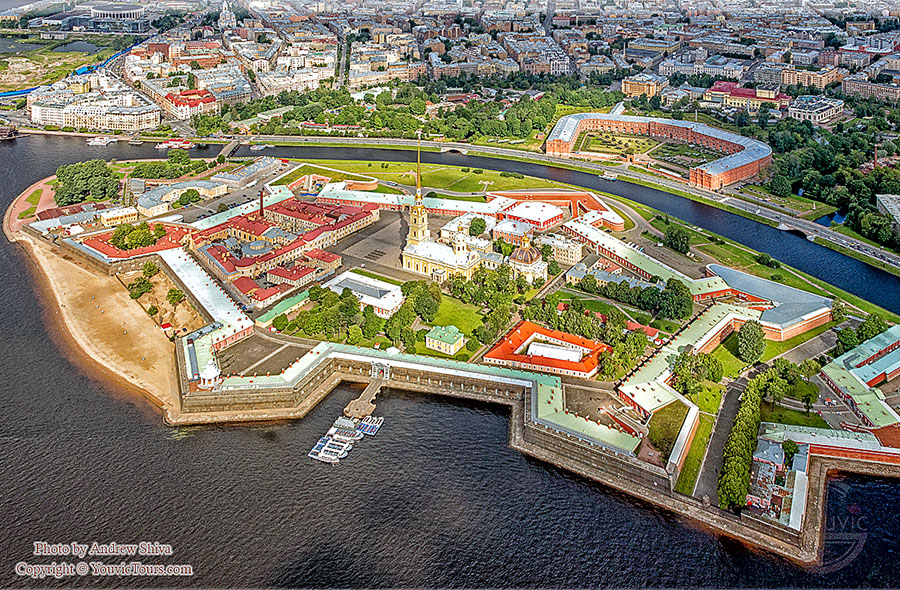
©Youvictours
The first construction of St. Peterburg took place on Hare Island in the River Neva with a fortress to defend the growing city from a Swedish attack. It never happened and by 1720, the fort also became a prison for political dissidents, the Imperial Mint, and provides the only beaches in the city.
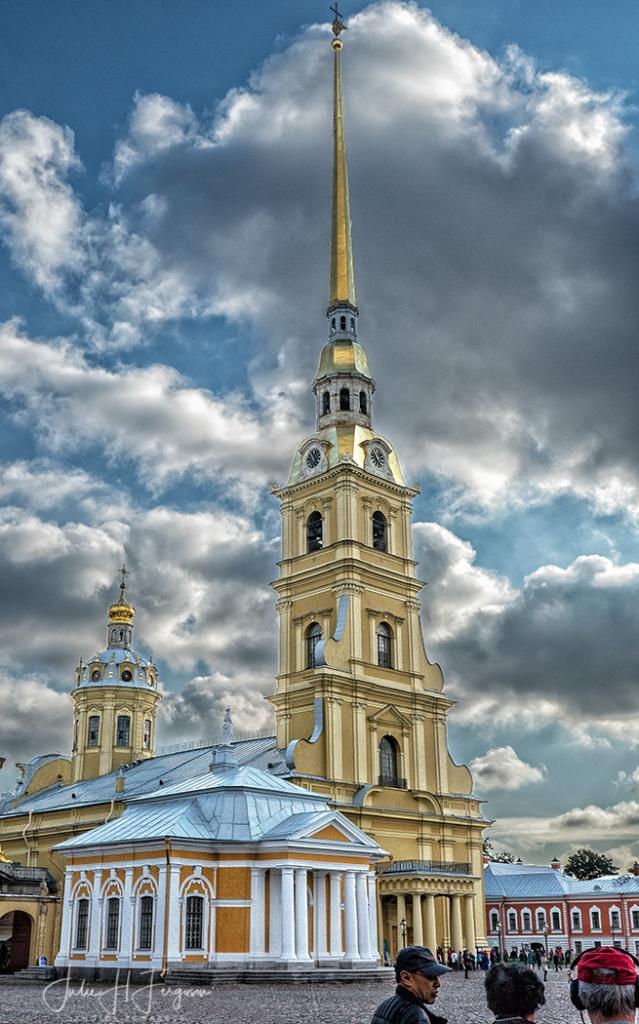
St. Peter and St. Paul Cathedral in the center of the fort was something of a pilgrimage for me. It is the Imperial burial vault that whispers Russia’s turbulent history to those who are attuned to it.
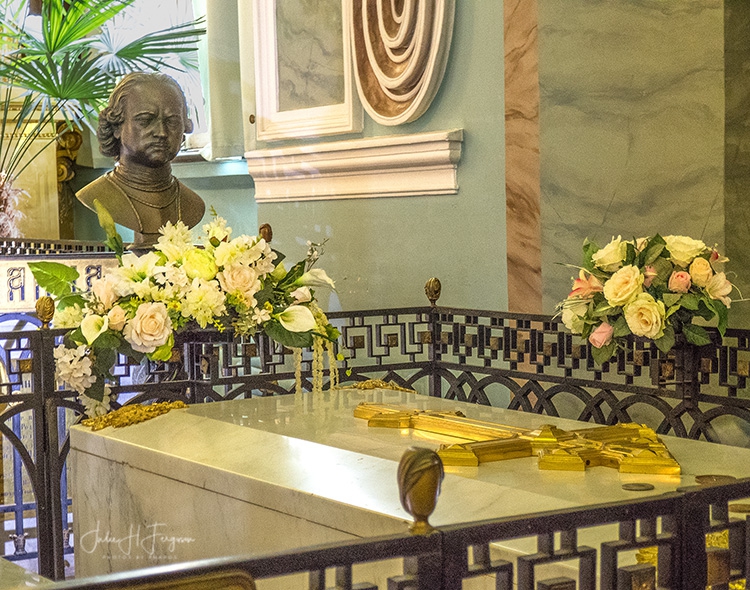
Peter the Great is buried here, as are all the Romanov tsars and tsarinas, including the last. Most tombs are white marble and those with the gold Imperial eagle in one corner indicate the tsars and empresses of Russia. I paused here for a while remembering Peter’s insatiable curiosity, vision, and achievements. Catherine the Great is also here.
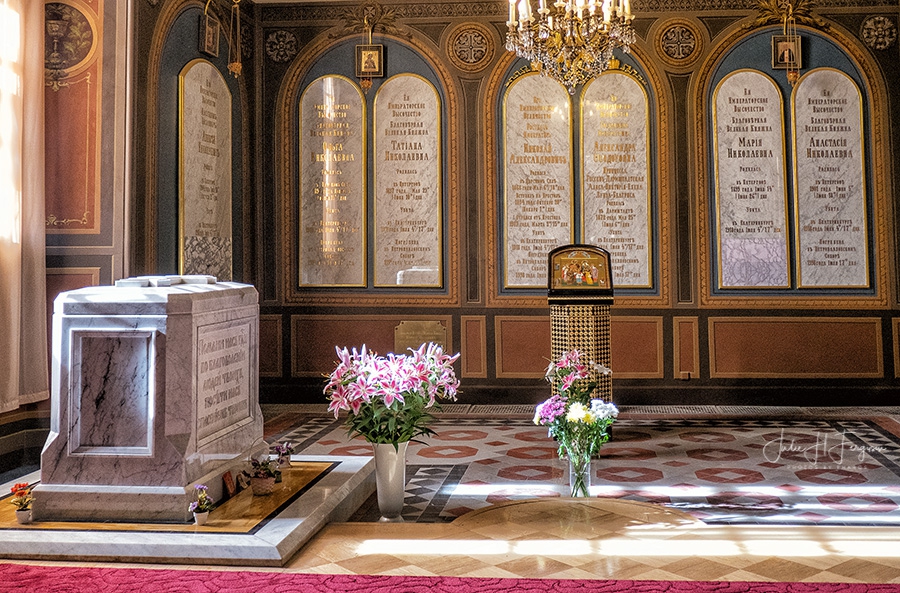
The remains of Nicholas II and family (except Maria) who were murdered in Ekaterinaburg in 1918, were interred after identification in the St. Catherine Chapel in 1998. At last, they are at peace in a beautiful and tranquil place where visitors can pay their respects.
After finishing the fortress, Peter began the city’s construction on Vasilyevsky Island and this is the location of all the major tourist sites.
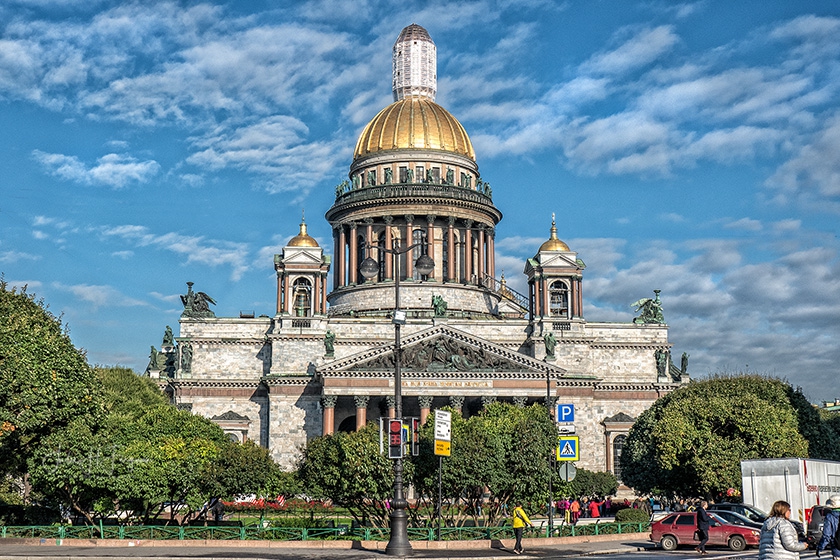
St. Isaac’s Cathedral dominates its square and can hold a congregation of 14,000 faithful. It was built from 1818 to 1858. I only had fifteen minutes here for exterior photography which was a pity.
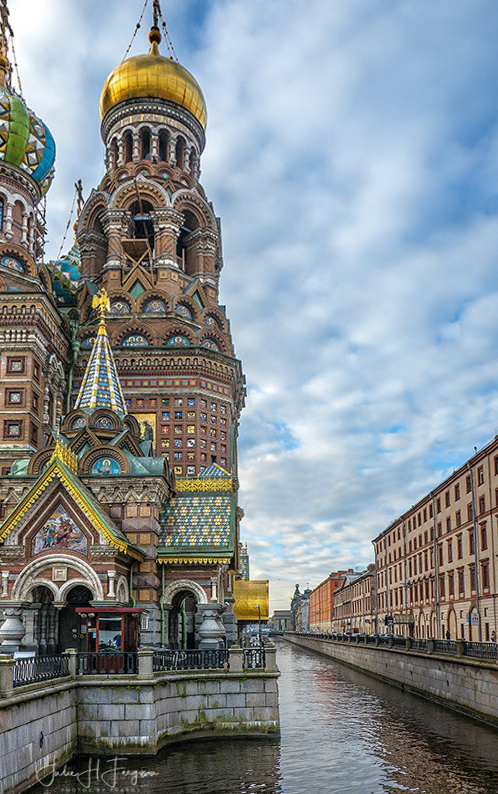
The Church of the Savior on the Spilled Blood is an astonishing example of late 1800’s architecture and memorializes the exact spot where Tsar Alexander II was assassinated in 1881. Inside, instead of paintings, the walls are covered with brilliantly colored mosaics. The church has never been a place for public worship but was solely used by the Imperial families for memorial services. Today it is a museum. It lies on the bank of the Griboyedov Canal, named the Catherine Canal before the 1917 Revolution, that leads to Nevsky Prospekt.
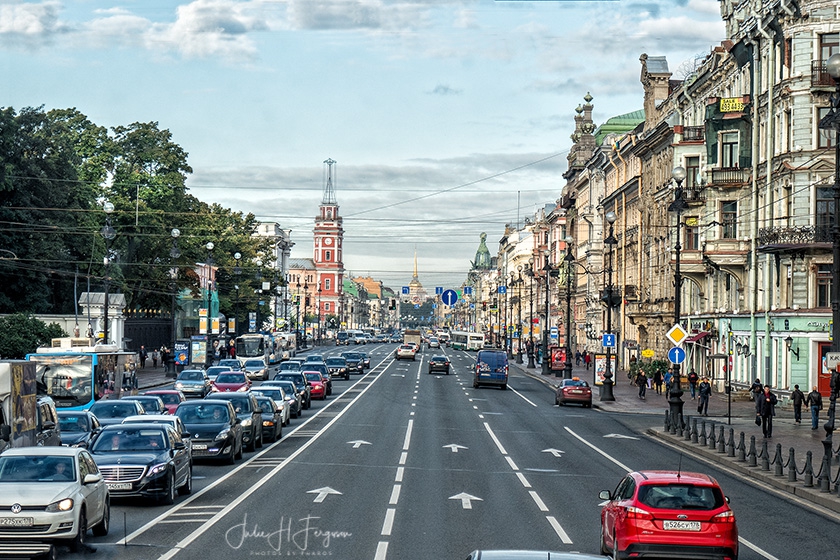
My coach drove down Nevsky Prospekt but did not stop. The main street of the city was built in 1738 and remains a center for finance, large corporations, and stores — I wanted time to meander along the famous street and window shop. I never got back to walk around the heart of St. P. and was beginning to realize that three full-days would not be enough to see all I’d hoped to visit.
Hermitage Museum St. Petersburg
The afternoon was devoted to the Hermitage Museum, a vast complex of palaces stretched along the River Neva that contains one of the world’s greatest collections of art. Three hours rushing round barely scratched the surface, but it was better than nothing — I longed to spend a day or two here on my own. Tour groups enter from the riverside and I never saw the immense square at the front where Russian Revolution history played out. I was so overloaded at the tour’s end, my brain seized up!

The Winter Palace of Catherine the Great, who married Peter’s grandson and deposed him after one year, is one of five buildings that make up the Hermitage. This is the riverside facade. Catherine had to expand it to house her rapidly growing collection of art that now contains three million pieces.

Elegant and majestic, the Grand or Jordan staircase makes visitors gasp as they arrive inside. Made of white marble, it sweeps up amid sculptures, paintings, columns, mirrors, and gilt decorations.
I saw throne rooms, great halls, and galleries, all packed with icons and masterpieces by Reuben, Rembrandt, da Vinci, and even Post-Impressionists, to name only a few. Catherine’s acquisitiveness is legendary, and her legacy, our bonus.
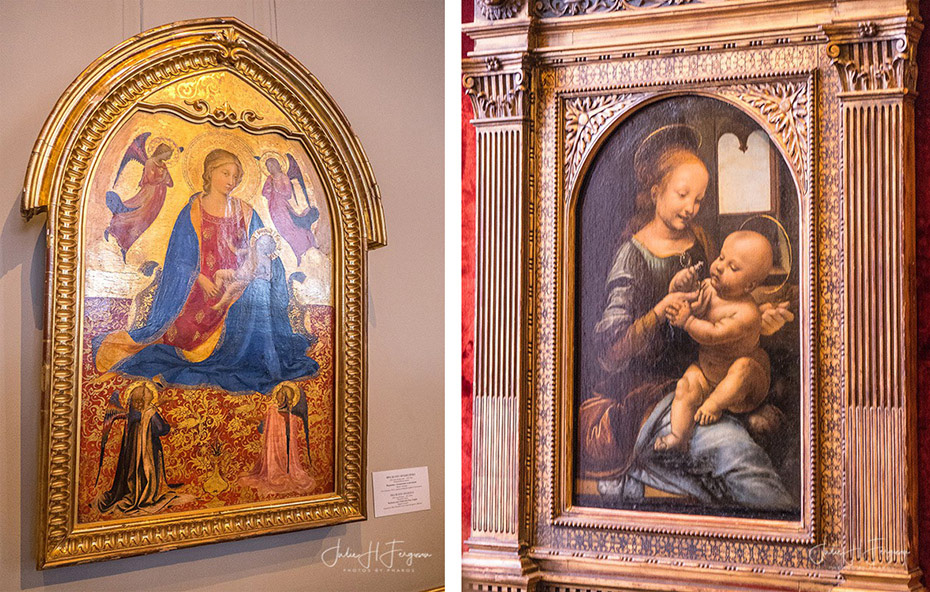
Four rooms in the Old Hermitage are devoted to Early Renaissance art mostly from Florence. L: Madonna and Child with Angels, Fra Angelico, 1425. R: The Benois Madonna, Leonardo da Vinci, 1478.
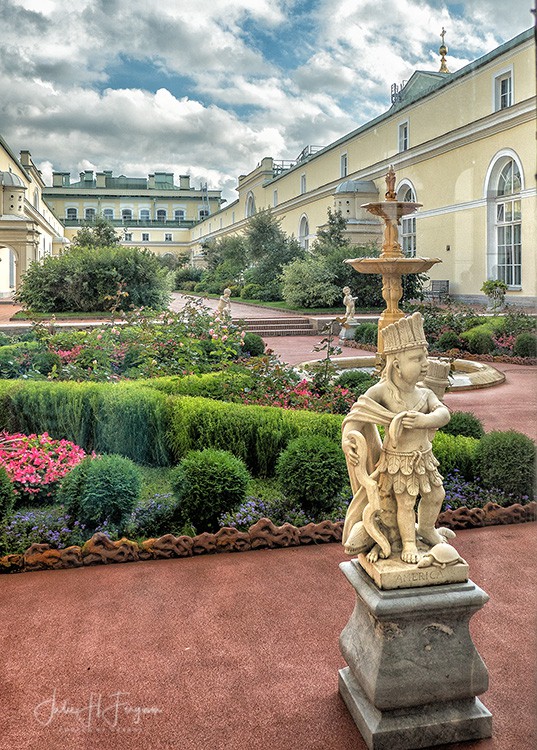
There’s a tranquil hanging garden joining the first floors of the Winter Palace and the Small Hermitage where I discovered the huge Peacock Clock from the 1700s.
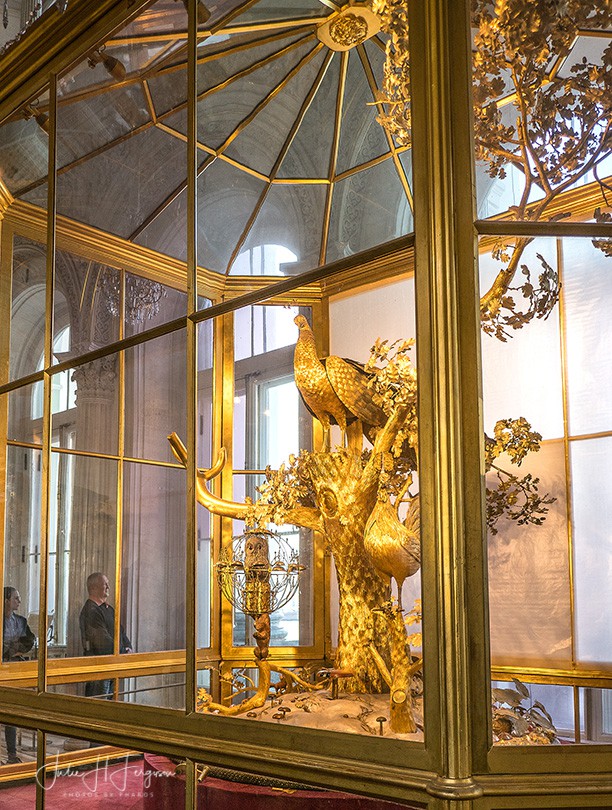
The mechanized Peacock Clock, created by a British goldsmith, is a wonder of 18th-century imagination and workmanship.

The Small Hermitage contains the Raphael Loggias, a reconstruction of the artist’s gallery in the Vatican from the early 1500s. Catherine the Great is responsible for this copy — between the arches and on the ceiling are Raphael’s frescoes; light pours in through tall windows and is reflected in mirrors.
Though the images don’t show the hordes of visitors, the Hermitage was overcrowded. Photography was a challenge: getting a clear shot of the artwork needed patience and good luck; light was often dim, and flash is not permitted; and reflections in the glass-covered paintings and objets d’art were difficult to avoid. I did my best but was often frustrated.
The final two days of my cruise at St.Petersburg were spent outside the city visiting Peterhof, Pavlovsk, and Pushkin (formerly Tsarkoye Selo). These palaces were favorites of the Imperial families who escaped to them in the summers.
Peter the Great’s Peterhof
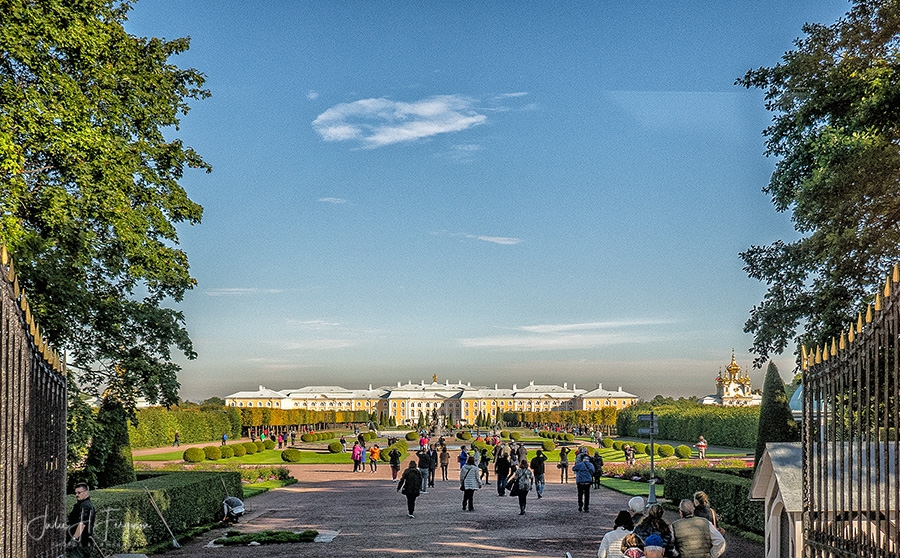
The southern entrance to Peter the Great’s magnificent Peterhof Palace, Peterhof, and the Upper Park. It’s famous for 150 fountains and four cascades within the 1000-hectare estate. It’s 23 miles (36 km) outside St. Petersburg on the Gulf of Finland and was opened in 1723.
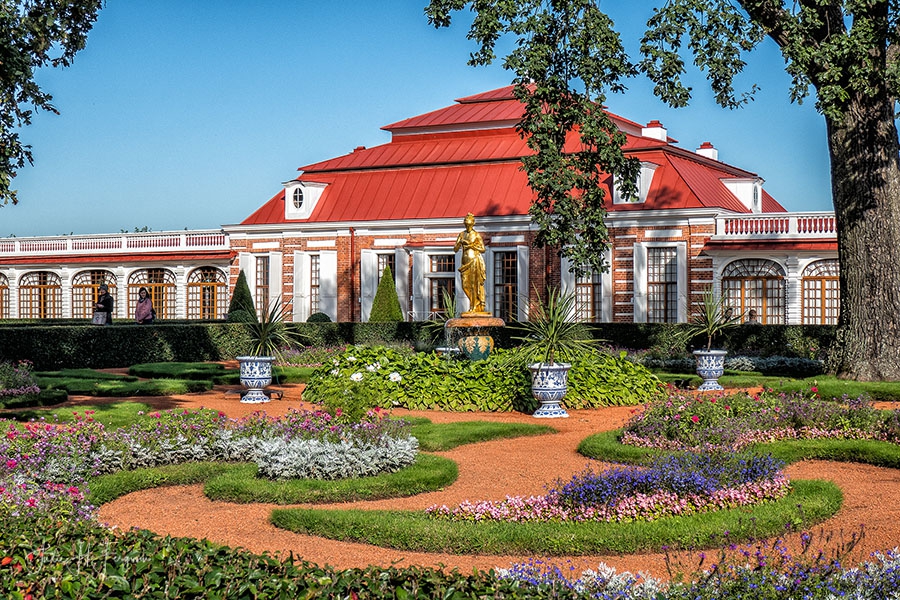
While the main palace was building, Peter designed and lived in this small residence on the seafront called Mon Plaisir. Here is the garden side of the building with a statue of Psyche. From images, the inside looks plain but comfortable in comparison to the bigger, more grandiose palaces.

After Peter died in 1725, work on the main palace ceased until 1740 when his daughter, the Empress Elizabeth commissioned a bigger and more elaborate building. (The north façade is seen here.) It was sumptuous inside and, sadly gutted by the Nazis in WW2. Today the interior is restored to its original splendor and open to the public. No photography is allowed, but I did not get inside. It is known as “Versailles of the North.”
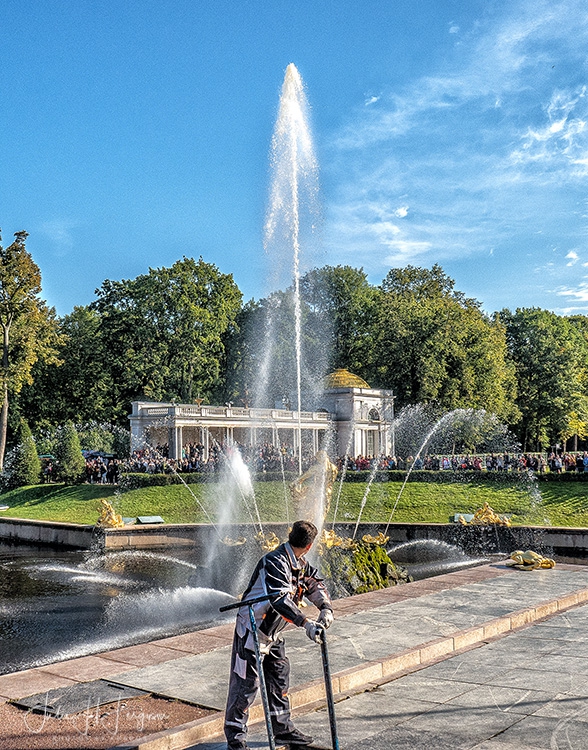
At precisely 11 a.m. every day a worker turns on Peter’s gravity-fed fountains to the accompaniment of classical music and applause. The terraces and stairs are overflowing with crowds all vying for the perfect image. I returned later when the sun was in a better position for photography and the crowds had dispersed.
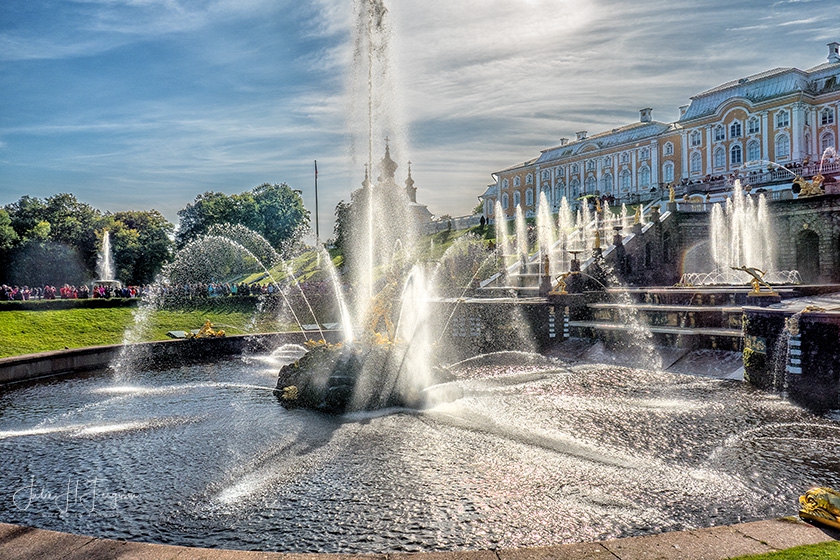
The great Samson Fountain in the center with one of two Grand Cascades to its right.
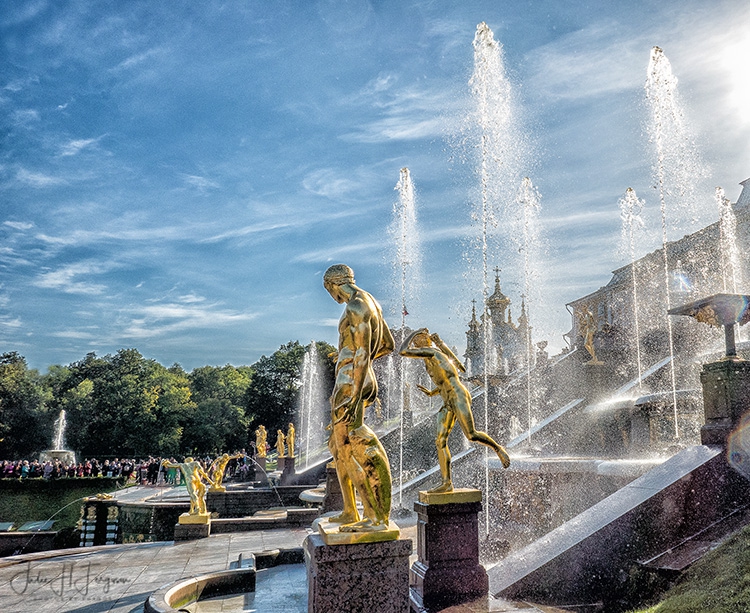
The Grand Cascades from the side. They are adorned by large gold statues, all different, from mythology. Behind are the domes of the chapel where the Imperial families worshipped, wed, and had all their children baptized.

The west Grand Cascade and the cupola atop the western wing of the palace, which I believe is a museum storeroom.
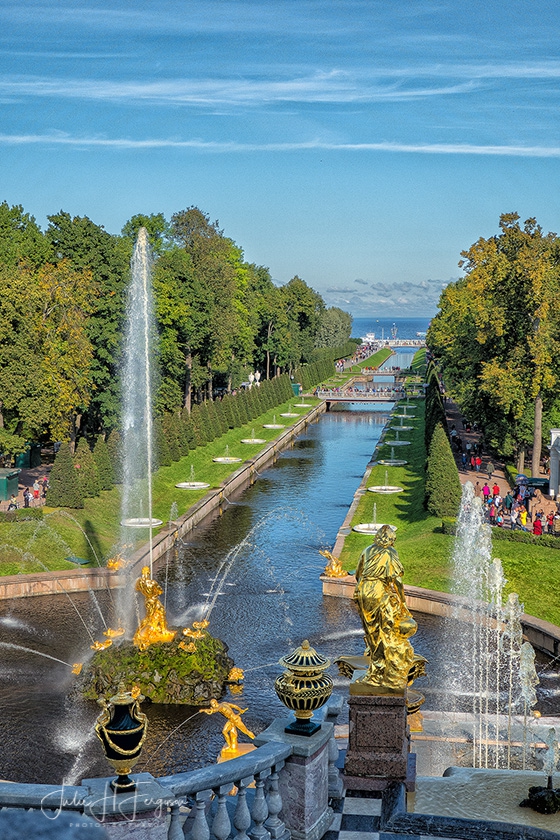
Taken from the terrace above the Grand Cascades, the Sea Canal, Lower Park, and the Gulf of Finland spread out below the palace. The park contains many gardens, more fountains, and several smaller palaces, and the walk is worth taking. On a clear day St. Petersburg’s skyline can be seen from the ferry dock at the end of the canal.
We returned to the ship for a 2:30 pm lunch and a few passengers took advantage of optional excursions — a boat trip on the canals, a ballet, and a night tour of St. Petersburg. Most were tired and the ship was quiet that night.
Paul I’s Palace at Pavlovsk
Our final day of the cruise was filled with exploring Paul I’s Palace at Pavlovsk and the Catherine Palace at Pushkin. It was another long day.
Catherine the Great gave her son, Pavel or Paul, 1500 acres (607 hectares) of hunting lands close to her palace at Pushkin about 18 miles (30 km) south of St. Petersburg. Paul and Maria, his wife, built a palace there in the late 1700s and landscaped the park in the English style. The couple furnished the palace extravagantly from the point of view of visitors in the 21st century, but it’s beautiful with a huge collection of artwork too. In the throne room, also used as the main dining room, is an exhibition of the Gold Dinner Service with 606 pieces. I didn’t have time to tour the park.
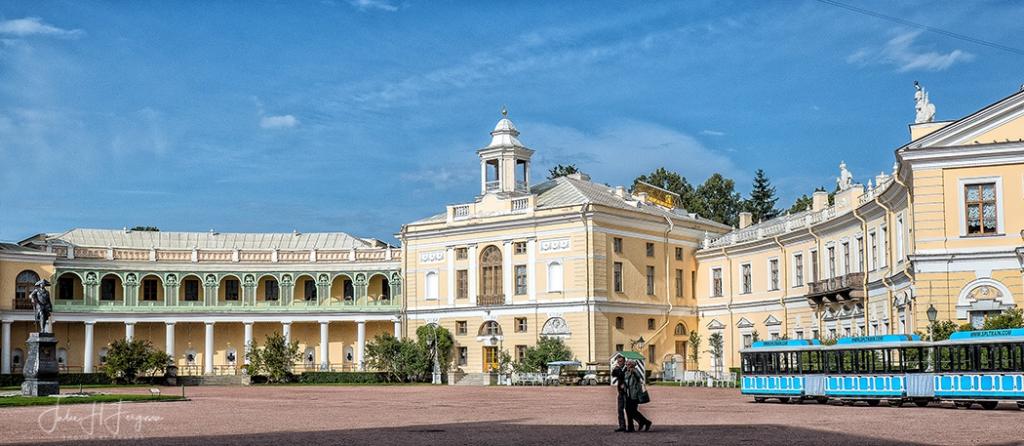
The Pavlovsk Palace’s semicircular and symmetrical design is welcoming and elegant. The statue on the left of Paul I was erected in 1872.

The staterooms at Pavlovsk are exquisitely decorated with themes from antiquity including Greece and Egypt. The Hall of Knights served as the Presence Chamber outside the private apartments and has a distinct Roman military theme. Paul I was the Grand Master of the Maltese Chivalric Order of Knights.
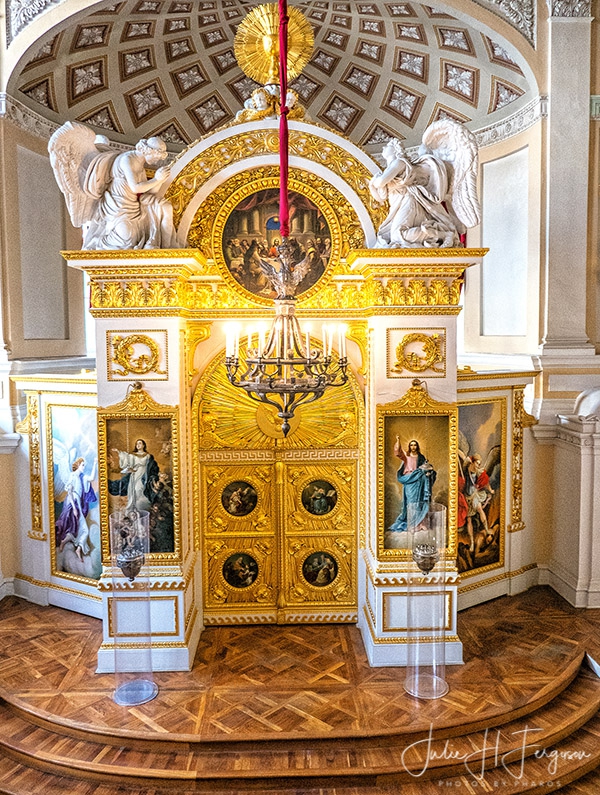
The 1799 chapel is a mix of Russian Orthodox and Catholic design because Paul leaned towards the Roman church — fewer icons and more sculptures.
Catherine Palace at Pushkin
The cruise’s glittering finale was visiting the opulent Catherine Palace. The estate lies in the town of Pushkin, previously called Tsarskoye Selo meaning the Tsar’s Village. The Soviets renamed the town in honor of Russia’s greatest poet.
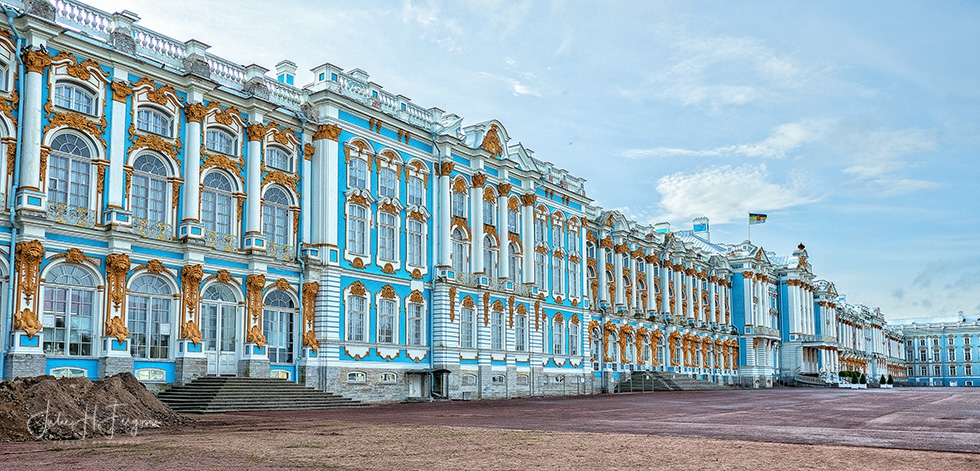
Visitors immediately can see the similarity between the Catherine and Winter Palaces from the front — Rastrelli designed both. Classic and elegant, the blue and white facades delight the eye.
Peter the Great gave the land to his wife Catherine I, who ruled briefly after his death. But it was his daughter, Empress Elizabeth I who completed the palace, and Catherine the Great who embellished it. I was in the first tour group of the day, which meant that we followed no crowds.

The Empresses of Russia is responsible for the Catherine Palace. L: Catherine I, Peter’s wife, for whom it was named; C: Elizabeth I, Peter’s daughter; R: Catherine the Great. These paintings hang in the Portrait Room. It was difficult to photograph them — the light was dim and the angles tricky.
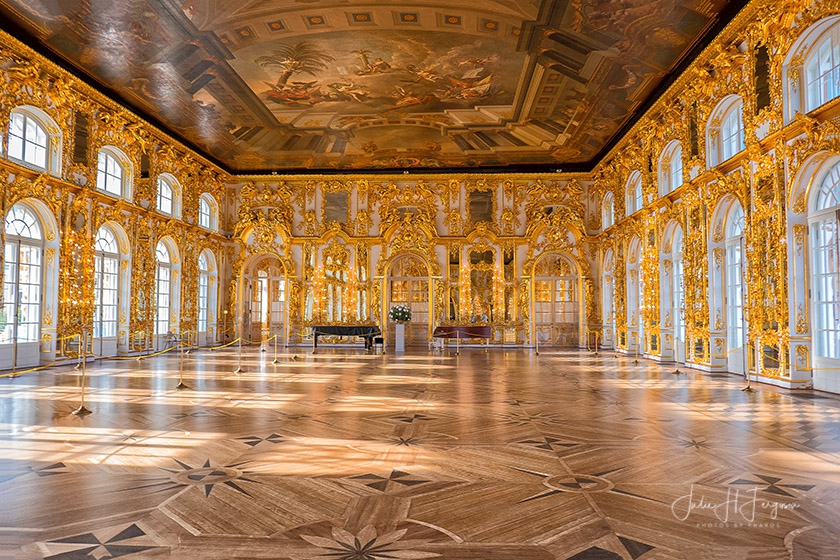
Visitors gasp at all the gold as they enter the Grand Hall. It is bright and airy with tall glass doors and mirrors, which increase the appearance of size. Behind the mirrors are stoves to heat this ballroom, reception room, and banquet hall. The painting on the ceiling is the “Triumph of Russia.”
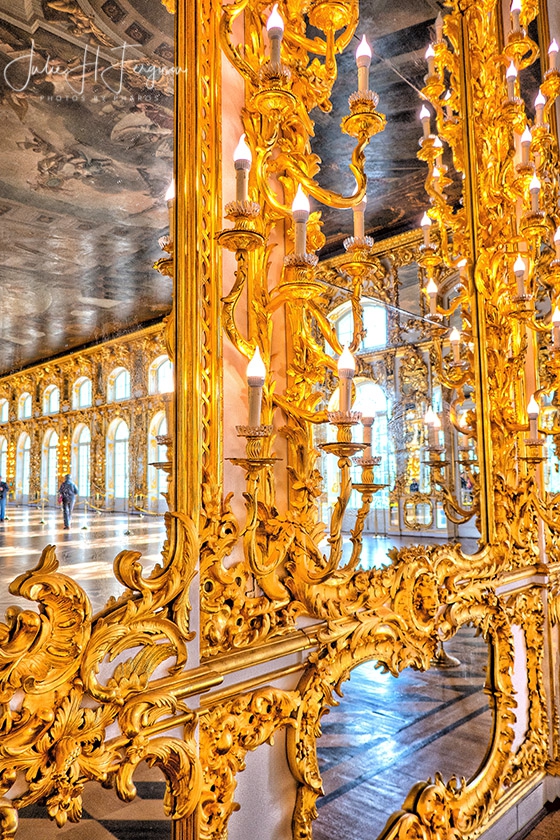
The Great Hall seen through two mirrors showing the elaborate Baroque decorations.
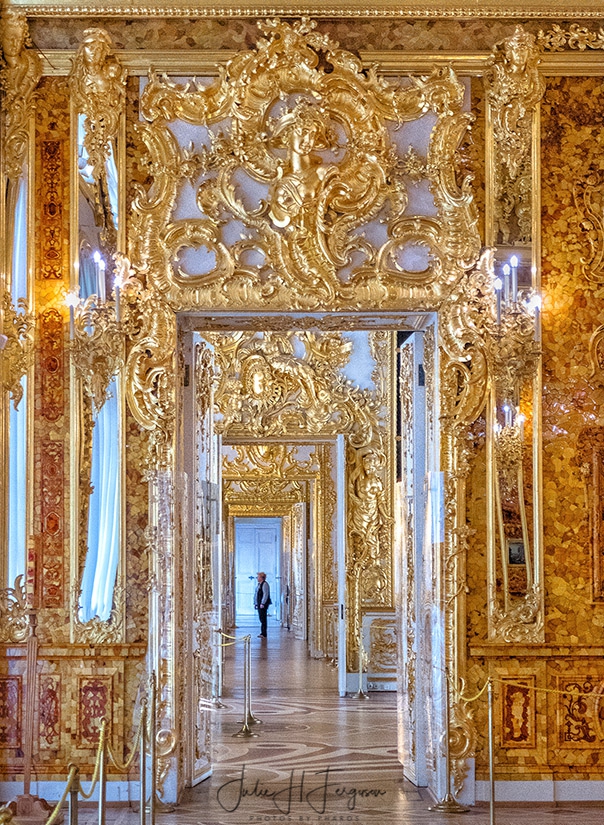
Known as the Golden Enfilade, the staterooms are all interconnected, and the rooms include small dining rooms, drawing rooms, and portrait rooms. The gilt decoration is breathtaking but a touch extreme three hundred years on.
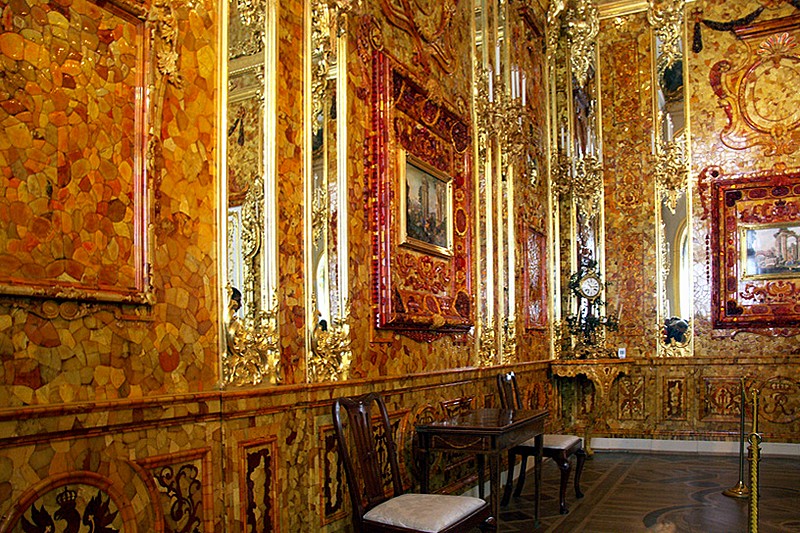
The legendary Amber Room is in the middle of the enfilade. It is stupendous with the walls covered in panels of mosaics of multi-colored amber stones that glow. This is a restoration following the Nazi’s theft of the panels in WW2 who hid them. They were never found and had to be remade in the post-war restoration at a cost of $12 million over a span of twenty years. No photography is allowed in here.
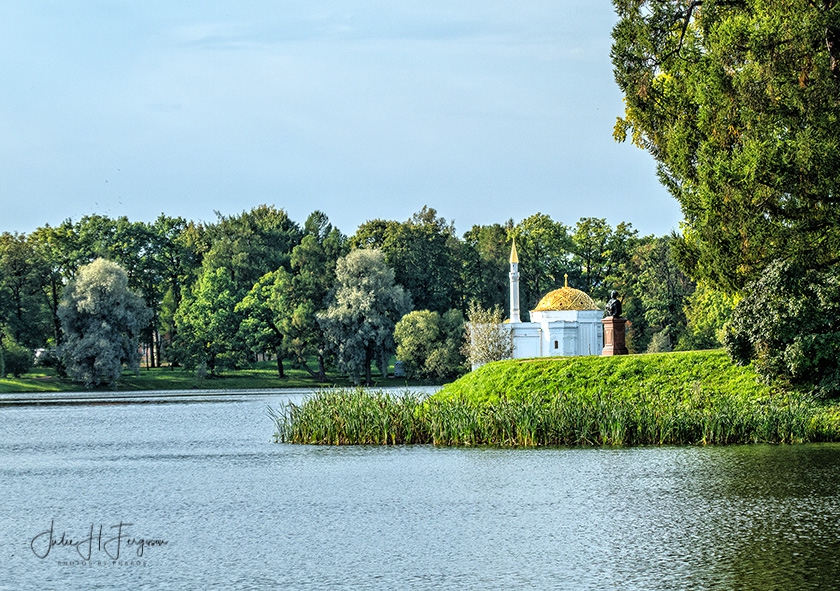
The park of Tsarskoye Selo is vast and filled with lakes, pavilions, gardens, and delightful walks. This man-made lake is called the Great Pond, and the mosque-like structure is the Turkish Bathhouse. Leave time to explore the park, it’s worthwhile.
The Catherine Palace was my favorite on the inside, but Peterhof had my favorite park. I’m thrilled that St. Petersburg ended my cruise on the Zasima Shashkov but three days wasn’t enough time, so I must return to savor more of the city and its history that began with Peter the Great.
Read Part I of My Very Russian River Cruise from Moscow to St. Petersburg here.
© Julie H. Ferguson 2018
All images: © Photos by Pharos 2017, except where noted on images.
Useful links for Moscow St. Petersburg Cruises:
Our hotel recommendations for St. Petersburg Russia: https://europeupclose.com/article/stay-st-petersburg/
Vodohod Cruise line: www.bestrussiancruises.com/
MV Zosima Shashkov deck plan: www.bestrussiancruises.com/ships/zosima-shashkov.html
Russian Tourist office: www.russiatourism.ru/en/
St. Petersburg Tourism: www.visit-petersburg.ru/en/ and www.stpetersburg.com
The Hermitage Museum: www.hermitagemuseum.org
Peterhof: www.saint-petersburg.com/peterhof/grand-palace/
Pavlovsk: www.saint-petersburg.com/pavlovsk/pavlovsk-palace/
The Catherine Palace, Pushkin: www.saint-petersburg.com/pushkin/catherine-palace/
Helpful Tips for Russian River Cruises:
- The Moscow to St. Petersburg cruise spends two days in Moscow and three in St. Petersburg. The reverse voyage from St. Petersburg spends only two days there.
- Book your airport transfers to and from ship ahead of time.
- Zosima Shashkov has no elevators. The cruise line has 3-4-5-star ships to choose from. The Shashkov was a 3-star vessel — very clean, but not luxurious.
- The young crew not always spoke English and customer service was lower than in North America. I had realistic expectations and was not disappointed.
- Passengers who had tried to use Moscow’s metro and buses before the ship arrived had much difficulty because of the Cyrillic alphabet signs with no translation and staff who didn’t speak English. The closest station was mile-walk from the cruise port through two parks. Not easy to find!
- Russians generally don’t speak English either, nor can they read the Latin alphabet. Google Translate was useful.
- Tipping for the crew, guides, and bus drivers is suggested and only in cash.
- Be prepared for large variations in temperature ( 78F to 50F; 26C to 10C) in late summer and rain. St. Petersburg is cold, even in late summer and sun is scarce.
- Mid-September was a good time to go, but the crowds in Moscow and St. P. were still huge in the main tourist sites.
- Rural communities and artisans rarely accept credit cards. ATMs are plentiful in towns, not so much in villages on the route. No ATM on the ship.
Highlights of St. Petersburg Russia – Pin for Later:


Julie H. Ferguson
Thursday 22nd of February 2018
Thank you, George, for your kind words. Much appreciated. Julie
George
Thursday 22nd of February 2018
A wonderful guide for tourists with incredibly beautiful photos! Thank you! I think that this article will help many of those who are going to come to St. Petersburg.